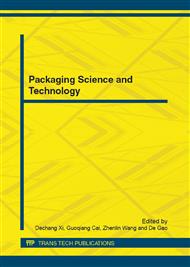p.416
p.423
p.427
p.433
p.437
p.442
p.446
p.451
p.455
Preparation of Biodegradable Phase-Change Refrigerant Used in Insulating Packaging
Abstract:
The starch grafted acrylic super absorbent resin was used as a basic material of refrigerant in insulating packaging. The influence of the amount of initiator on water absorption ability of starch grafted acrylic super absorbent resin was investigated. When the amount of initiator is 4 percent of the starch, the resin's water absorption that is 230g/g displays the best. By adding NaCl solution, the phase change temperature of refrigerant can be conditioned. The experimental results show that the phase change temperature and the latent heat of refrigerant decrease as the NaCl solution concentration increases. The starch grafted acrylic super absorbent resin and the NaCl solution with the concentration of 0~5 percent as refrigerant can be used to transport the products whose required temperatures is between -4 and 0°C. The starch grafted acrylic super absorbent resin can replace the ordinary high polymer materials, playing the role of being easily biodegradable and friendly to environment.
Info:
Periodical:
Pages:
437-441
Citation:
Online since:
October 2012
Price:
Сopyright:
© 2012 Trans Tech Publications Ltd. All Rights Reserved
Share:
Citation:


